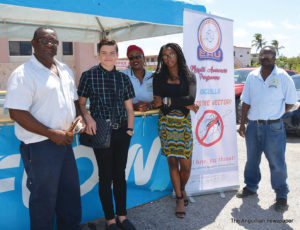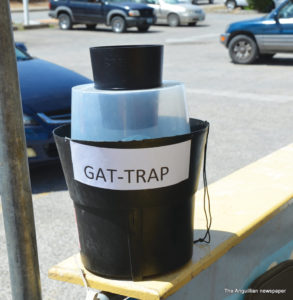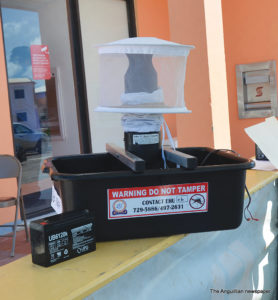
Mosquito Awareness Week culminated on Friday, May 17th, with a team from the Department of Health Protection meeting the public at Scotia Bank grounds to give advice and instructions on controlling the spread of mosquitoes and rodents.
Ms. Shandette Carty, Vector Control Officer, together with Mr. Alex Fleming, Senior Vector Control Officer, were on hand to provide information on the various traps and poisons that are available to capture mosquitoes and rats – pests that are prone to cause diseases and put the public’s health at risk.
One of the traps on display was the Gravid Trap. At the bottom of the trap is a tray that holds hay mixed with a gallon of water to attract mosquitoes. This trap employs the use of a battery that runs a fan to produce an updraft of air which propels the mosquitoes from the water in the tray into a collection bag at the top of the trap, and the upward air current keeps them there.
This trap was designed by Dr. Paul Reiter, of the U.S. Centers for Disease Control, to collect gravid Culex mosquitoes. Gravid mosquitoes are the mosquitoes that are pregnant with eggs. By means of this trap the reproduction of mosquitoes can be drastically reduced.
Another model of a trap on display was the GAT-Trap. GAT stands for Gravid Aedes Trap, and is designed particularly to capture pregnant Aedes Aegypti mosquitoes.
 According to entomologytoday.com, the GAT-Trap was developed by scientists in Puerto Rico. Unlike the Gravid Trap, the GAT-Trap uses no electricity. It is as far from high-tech as one can get, but it is quite efficient, and is ideal for the backyard.
According to entomologytoday.com, the GAT-Trap was developed by scientists in Puerto Rico. Unlike the Gravid Trap, the GAT-Trap uses no electricity. It is as far from high-tech as one can get, but it is quite efficient, and is ideal for the backyard.
It allows mosquitoes to enter a black funnel into an inverted translucent bucket which sits on a black base containing hay and water, much like the Gravid Trap. The color black is known to attract female mosquitoes which have been observed to enter the GAT even without bait. The translucent bucket is greased with canola oil, and as the mosquitoes are lured by the

attractant they fly against the greasy walls of the bucket and are trapped.
To entrap rodents, a highly effective rat poison was also displayed. This is very toxic, and anyone who uses it must wear gloves and must be extremely cautious to avoid the pesticide from contacting the skin.
The rat poison and traps are available to anyone who desires to use them. The personnel at the Department of Health Protection are more than willing to assist such persons with the deterrents. Persons caring to use then may contact Shandette or Alex at the department by calling at 497-2631.
Staff Reporter: James R. Harrigan







